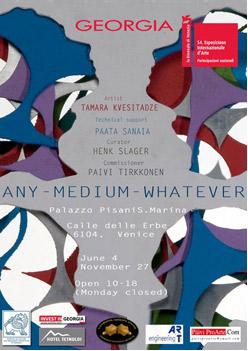Georgian Pavilion at the Venice Biennale
54th Esposizione Internazionale La Biennale di Venezia
Giardini della Biennale
Venezia, Italia
Location and Public Hours
Palazzo Pisani Santa Marina
Calle delle Erbe, Cannaregio, 6104, Venice
June 4–November 27, 10am–6pm (Monday Closed)
Contact and Information
Martina Phaler
paiviproarte@gmail.com
biennaleproarte@gmail.com
Tel. + 39 345 6470890
Tel. (Fax) + 39 0435 74012
reported by
e-flux
shared by numero civico rovereto


Georgian Pavilion at the Venice Biennale
Any-Medium-Whatever
Artist: Tamara Kvesitadze
Curator: Henk Slager
Commissioner: Paivi Tirkkonen
Opening and Panel Discussion
June 3, 18.30
International Art School
Workshop, June 6–12
Tamara Kvesitadze's reflection on visual art surpasses any medium-specific category. The way she is dealing with various media can be described most aptly by the term "whatever," in the positive sense of "being such that it always matters." One could indeed argue that Kvesitadze's artistic practice engages in what Gilles Deleuze in What is Philosophy would call "a non-philosophical understanding of philosophical matters."
Deleuze elucidates how art idiosyncratically generates a form of thought and knowledge that is able to contribute to an understanding of the human condition—a form of thought and knowledge that is very different from the discursive modalities philosophy deploys. Because of that dynamic of being different, the visual production of ideas can never be comprised in static systems of signification or well-defined frameworks of interpretation. The visual production of ideas and its continuous concentration on the singular—going beyond notions such as the individual or the universal—ostentatiously strives against the reductive violence of any regime based on a logic of similarity.
While resisting such logic, Kvesitadze's work denies access to homogenization, instrumentalization, territorialism, or any system of condensation into one anthropological condition. Rather, her artistic practice embraces a focus on mutating processes in the comprehension of the powers and desires of humankind. After all, art's task is to reflect on the transcendental preconditions of human life: art searches for what connects people, or for what will be connective possibilities.
A process implying the force and passion of interruption and metamorphoses is at the core of the work the viewer encounters when entering the exhibition space in the Palazzo Pisani Santa Marina. Kvesitadze's work F=-F consists of a wall construction where a sculpture of compressed human faces is to be seen: a multitude of nameless faces where even each form of singularity seems suppressed.
Behind the wall, the installation Sphere shows the dynamic reality of processes of mutation and transformation, of human beings as the builders of "spheres." The human being as a being who, in being aware of the fact that he/she has to live on a globe or a sphere, designs the world again and again (Sloterdijk). This process where the tension between earth and world (territory) is at the core could be characterized as a diffused zone resulting from two continuously resisting movements of reterritorialization and deterritorialization. As a living sculpture Sphere articulates such traversing as an anthropological condition in transformation: a continuous striving for a better life versus an institutionalized tyranny of one over many.
The architecture of the Palazzo Pisani and its parallel inner courtyard allows the presentation of Kvesitadze's work to indeed withdraw from a compelling binary exhibition logic. The courtyard suddenly presents itself to the visitor as a third space—an environment no longer dominated by a territorializing awareness. That view is enhanced by a series of fresco-like panels, the work Relationship, stretching from floor-to-roof, seemingly referring to Tamara Kvesitadze's modes of artistic thought, its envisioned singularities, its planetary worlds to be designed, its possible worlds to be expressed. An artistic form of thought as a process of illumi-nation, visualizing novel forms of human communities free from ontological determination, free from the homogenizing connection between geographic location and identity.
Georgian Film Screenings:
June 1–2: Mikhaïl Kobakhidze retrospective, 4–6 pm.
June 4–10: N. Jujunadze, G. Shengelia, K. Miqaberidze, M. Kalatozov, T. Abuladze, R. Chkheidze, 4-6 pm.
Panel discussion: June 3, 6.30 pm.
Panelists: Nicolas Bourriaud, Johnson Chang, Kwok Kian Chow, Chris Dercon, Chus Martinez, Manu Park, John Rajchman and Mick Wilson (moderator).
International Art School Workshop: June 6–12, with a.o. Sarat Maharaj, Mick Wilson, Jan Kaila and Tiong Ang. Collaboration maHKU (Utrecht Graduate School of Visual Art and Design), Center of Contemporary Art Tbilisi, Finnish Academy of Fine Arts (Helsinki) and IUAV (University of Venice, Faculty of Visual Art and Design).
Location and Public Hours
Palazzo Pisani Santa Marina
Calle delle Erbe, Cannaregio, 6104, Venice
June 4–November 27, 10am–6pm (Monday Closed)
Contact and Information
Martina Phaler
paiviproarte@gmail.com
biennaleproarte@gmail.com
Tel. + 39 345 6470890
Tel. (Fax) + 39 0435 74012


